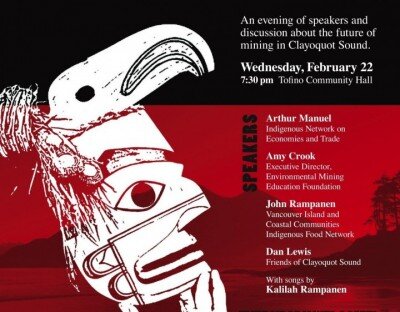Today, the cultural landscape of Clayoquot Sound honours a diverse array of ethnicities and backgrounds, each with unique and significant teachings and insights waiting to be shared. It has been more than two hundred years since these lands have become co-inhabited and it appears that we, as a people, are now prepared to take courageous steps to move forward together, to build cultural bridges and forge a new path that honours and recognizes a truer history, a deeper understanding of where we are and where we would like things to be for future generations.
The Public Forum: Mining Clayoquot’s Future? was one of these momentous steps. Local leadership (including hereditary chiefs and delegates), members from all surrounding communities, business owners and concerned citizens alike gathered together in February to discuss the future of mining in Clayoquot Sound.
—John Rampanen, forum speaker
A world renowned ecological treasure, the Clayoquot Sound UNESCO Biosphere Reserve is now threatened by two major mining projects proposed by Imperial Metals. Dan Lewis, executive director of Friends of Clayoquot Sound, makes the opening remarks at a recent public forum in Tofino, BC, titled “Mining Clayoquot’s Future?” Lewis called for aboriginal and non-aboriginal people to come together to discuss the proposed projects and find solutions to the challenges they pose.
Several chiefs representing the Ahousaht First Nation — whose traditional territory the proposed mine at Catface Mountain would impact — address the audience, emphasizing the importance of listening to their voices and of balancing environmental stewardship with employment-yielding resource development.
Terry Dorward, councillor for the Tla-o-qui-aht First Nations, discusses his community’s opposition to one of these mines which would affect their traditional territory.
Arthur Manuel, of the Indigenous Network on Economics and Trade, discusses the implications of aboriginal title and rights with respect to mining and other resource-related development.
Amy Crook, executive director of the Environmental Mining Education Foundation, has worked for decades with aboriginal communities across Canada dealing with mining projects. She stresses the importance of First Nations and citizens in and around Clayoquot Sound to engage in open discussion and determine what kind of a future they want for the region — before it is imposed on them by outside forces.
Eleven-year-old singer/songwriter Kalilah Rampanen adds her voice to the chorus of concern over one of these projects, singing her song about defending Chitaapi, also known as Catface Mountain. Her blend of traditional Nuu-chah-nulth and contemporary acoustic musical expression is an empowering reminder of the strength and beauty that emanates from our next generation.
John Rampanen, of the Vancouver Island and Coastal Communities Indigenous Food Network, discusses his family’s connection to the land that would be impacted by a mine proposed for Catface Mountain.
The Tla-o-qui-aht Initiative for Interconnected Community Health — or TIICH, which means “alive” in the Tla-o-qui-aht language — is a new, loosely formed group of Tla-o-qui-aht First Nations members who have come together to celebrate their culture through community initiatives that recognize the interconnectedness of all living things.
These videos and more about Clayoquot Sound are available for viewing on the FOCS YouTube channel.
